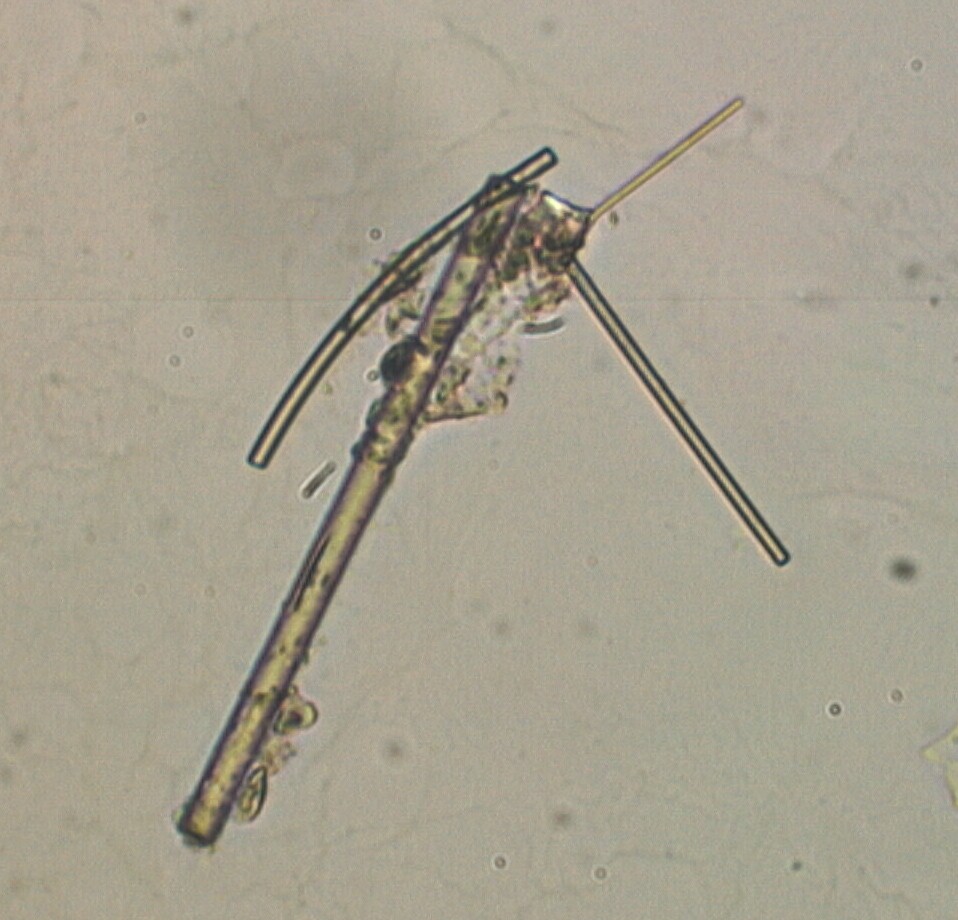Debris from a Yellow Bodied Acoustic Ceiling Tile
This field contains glass fiber with yellow phenolic binder and a few associated particles.
Transmitted Off Crossed Polarized Light Illumination
"Glass fiber", as identified by light microscopy, is defined by its morphology and a few optical properties. Its cylindrical shape (a result of surface tension at elevated temperature) is best seen by the relief gradient at the edge of the fiber when viewed with transmitted oblique illumination. The random molecular structure is demonstrated by the fact that the fiber is isotropic (disapears in all orientations when viewed between linear polarizing filters at 90 degrees to one another). The brittle nature of the fiber is shown by the lack of plastic deformation at the terminations of the fiber.
Glass fiber from acoustic ceiling tile is identified by the binders and fillers stuck to the outside of the fiber and the lack of impacted debris adhering to the fibers. Ceiling tile is a molded material and the molding process imposes certain compositional demands and limitations. A binder must be present in sufficient quantity to impart some rigidity to the tile. The binder is relatively expensive so it is often extended by adding mineral fillers. Flexible fibers, such as paper fiber or plastic fiber, may be added to impart greater durability to the tile. The presence of these materials physically attached to the glass fiber identifies the fiber as being from acoustic ceiling tile. The type of acoustic ceiling tile is identified by the composition of the attached materials.
http://www.microlabnw.com/index/Glass%20Fiber%20and%20Health%20Complaints.pdf
Parker, Sybil P. (ed), McGRAW-HILL ENCYCOPEDIA OF PHYSICS, ISBN 0-07-045253-9, p.27.
Definition/Function:
Glass fiber is a fiber composed of a material in a "glassy" state. A "glass" is any of a large class of materials that solidify from a molten state without crystallization and with random molecular orientation. They are regarded physically as supercooled liquids rather than true solids (based on the definition in the AMERICAN HERITAGE DICTIONARY). Chemically they generally contain silicon along with a number of other elements though carbon-based glasses are also common in some environments. It is estimated that there are in excess of 50,000 different chemical compositions for glass (MATERIALS HANDBOOK, by George S. Brady and Henry R. Clauser). Glass is easily formed at elevated temperature and can be made into fibers intentionally, as an artifact of thermal forming, or as a natural process as in the case of volcanic glass fiber (Pele's Hair)."Glass fiber", as identified by light microscopy, is defined by its morphology and a few optical properties. Its cylindrical shape (a result of surface tension at elevated temperature) is best seen by the relief gradient at the edge of the fiber when viewed with transmitted oblique illumination. The random molecular structure is demonstrated by the fact that the fiber is isotropic (disapears in all orientations when viewed between linear polarizing filters at 90 degrees to one another). The brittle nature of the fiber is shown by the lack of plastic deformation at the terminations of the fiber.
Glass fiber from acoustic ceiling tile is identified by the binders and fillers stuck to the outside of the fiber and the lack of impacted debris adhering to the fibers. Ceiling tile is a molded material and the molding process imposes certain compositional demands and limitations. A binder must be present in sufficient quantity to impart some rigidity to the tile. The binder is relatively expensive so it is often extended by adding mineral fillers. Flexible fibers, such as paper fiber or plastic fiber, may be added to impart greater durability to the tile. The presence of these materials physically attached to the glass fiber identifies the fiber as being from acoustic ceiling tile. The type of acoustic ceiling tile is identified by the composition of the attached materials.
Significance in the Environment:
Glass fiber on surfaces has been associated with a number of health complaints and with the "Sick Building Syndrome" in general. This is not true of glass fiber collected in air samples. The reason for this seems to be that in most cases in offices, schools, and homes the transport to the upper respiratory system is the result of mechanical disturbance and transport from contaminated surfaces and not from elevated airborne loading (see references in the microlabnw paper cited below).Characteristic Features:
Glass fiber may be distinguished from bird feather barbules by the low birefringence of the barbules and by accessory structures (nodes) on the barbules, if present. Glass fiber may be distinguished from silaceous phytoliths by accessory structures on the phytoliths, the low refractive index of the phytoliths (less than 1.500), by surface texture on the phytoliths, or by the non-cylindrical shape of the phytolith. These properties exclude most silaceous phytoliths from confusion with glass fiber unless a lower refractive index glass fiber is present, such as fused quartz (refractive index of 1.48).Associated Particles:
The source of glass fiber in an environment is identified by the types of materials associated with the glass fiber. Chemical composition is often unreliable because of variations in the chemical composition of the glass itself and because of surface films or particle adhering to the fiber that alter its chemical signature. Binders and the fillers, extenders, and pigments that may be associated with the binders attached to the fiber are a good indication of the fibers source. In addition to the binder there are often other fiber types attached to the glass fiber by the binder that further clarify the source of the glass fiber.References:
Brady, George S. and Henry R. Clauser, MATERIALS HANDBOOK, 11th Edition, ISBN 0-07-007069-5, pp. 341-350http://www.microlabnw.com/index/Glass%20Fiber%20and%20Health%20Complaints.pdf
Parker, Sybil P. (ed), McGRAW-HILL ENCYCOPEDIA OF PHYSICS, ISBN 0-07-045253-9, p.27.


